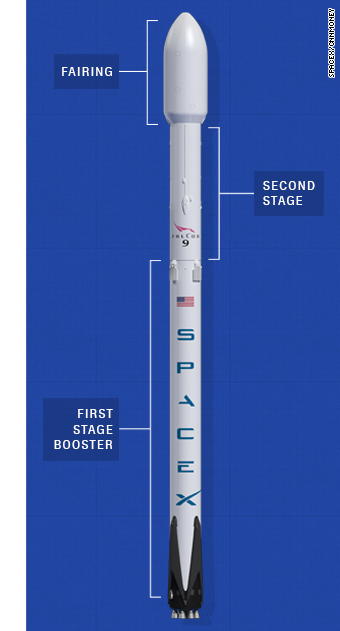
A SpaceX rocket launch grabbed the public's attention once again Friday when a ship wielding a net made a failed attempt to grab the rocket's fairing as it fell back to Earth.
Wait, what?
1. What is a fairing?
The nose cone, or fairing, is located at the very tip of the rocket. It acts a shield for satellites during launch. Once the rocket is in space, the fairing splits into two and falls away. After most rocket launches, the fairing is left to plummet toward a watery grave in the ocean.

2. What did SpaceX do?
SpaceX doesn't want its fairings to become fish food. If it can recapture the $6 million fairing and reuse it, that will save the company a bundle of cash.
So, after a routine launch of its Falcon 9 rocket on Friday, the company attempted to save the fairing before it splashed into the ocean.
3. How would capturing the fairing work?
That's exactly what SpaceX is trying to figure out.
The company has always said it wants to reuse as much of its rockets as possible, but recovering and reusing a fairing has never been done before. And it's taking some trial and error.
Friday's attempt was noteworthy because we got to see the latest iteration of SpaceX's plan — and it's a trip.
If the whole thing went down as desired, it would look like this: The fairing halves would guide themselves back through the Earth's atmosphere using tiny thrusters before deploying parafoils, which are a type of parachute, to slow down the descent. Using on-board navigation systems, the fairing would then steer itself into a net held up by a boat, called Mr. Steven.
4. What is Mr. Steven?
It's a crew boat that belongs to a family-owned business in Louisiana. Mr. Steven, built in 2015, was originally intended to work as a supply ship for the oil and gas industry.
But SpaceX landed a secretive deal to use the ship for its fairing recovery efforts, and the vessel has been retrofitted with a claw-like structure that hoists up the net to form a giant catcher's mitt.
Its name — since you're definitely curious — is a nod to the ship's owner, Steven Miguez. He's the patriarch of the Miguez family, and other ships they own follow a similar naming scheme. The offshore supply ship Mr. Blake, for example, is named for Blake Miguez, Steven's son, who is now the CEO of SeaTran.
Other information about Mr. Steven's association with SpaceX is hard to come by. SeaTran signed a non-disclosure agreement about the deal.
Mr. Steven made its public debut last month when Musk shared an image of the ship ahead of a February 22 launch. After that launch, the fairing missed Mr. Steven's net and made a soft landing in the ocean.
5. What happened Friday?
Musk said in a tweet that the fairing's parachute became tangled as it plummeted to Earth, so it made a crash landing in the ocean. And when speeds faster than the speed of sound are involved, hitting the ocean's surface does nothing to cushion the blow, so the fairing was more than likely destroyed.
He explained the issue: "Air wake from fairing messing w parafoil steering."
That just means the way the air moved around the fairing messed up the parachute.
6. What will SpaceX do next?
Musk said SpaceX will make some tweaks, and run some tests by dropping fairing halves out of a helicopter. They'll try this "in the next few weeks."
Musk also said he hopes Mr. Steven will become a regular part of SpaceX's launch webcasts, just as the company airs its rocket booster landings.
"Aiming to improve the link quality so it can be real-time," he said in a tweet.
7. Why can SpaceX land rocket boosters but not fairings?
You've probably heard about SpaceX landing first-stage rocket boosters on ground pads or droneships, which are autopiloted platforms that catch rockets out at sea.
The first-stage booster is the bottom part of the rocket with all the massive engines that give the rocket its first boost at liftoff. After it reaches space, the first-stage booster detaches, and the second-stage of the rocket fires up its own engine in order to finish the mission off.
While other companies typically discard rocket boosters after launch, SpaceX has the ability to land, refurbish and fly them.
It's been a game-changer in terms of bringing down launch costs. The first-stage booster accounts for about 60% of the cost of a new Falcon 9 rocket, according to Musk.
But figuring out how to land the rocket boosters after launch also took some trial and error.
And the process for recovering a fairing will have to be quite different. While the rocket booster has its engines and special hardware called grid fins to help guide it to safety, the fairing is essentially just a large, curved piece of metal.

